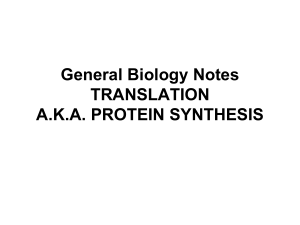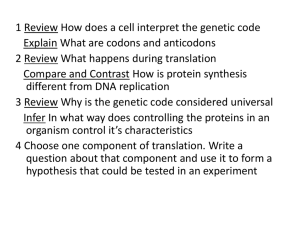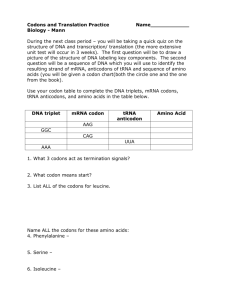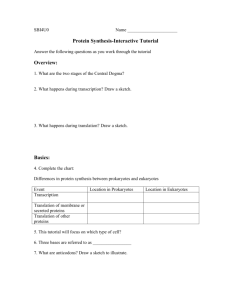mRNA
advertisement
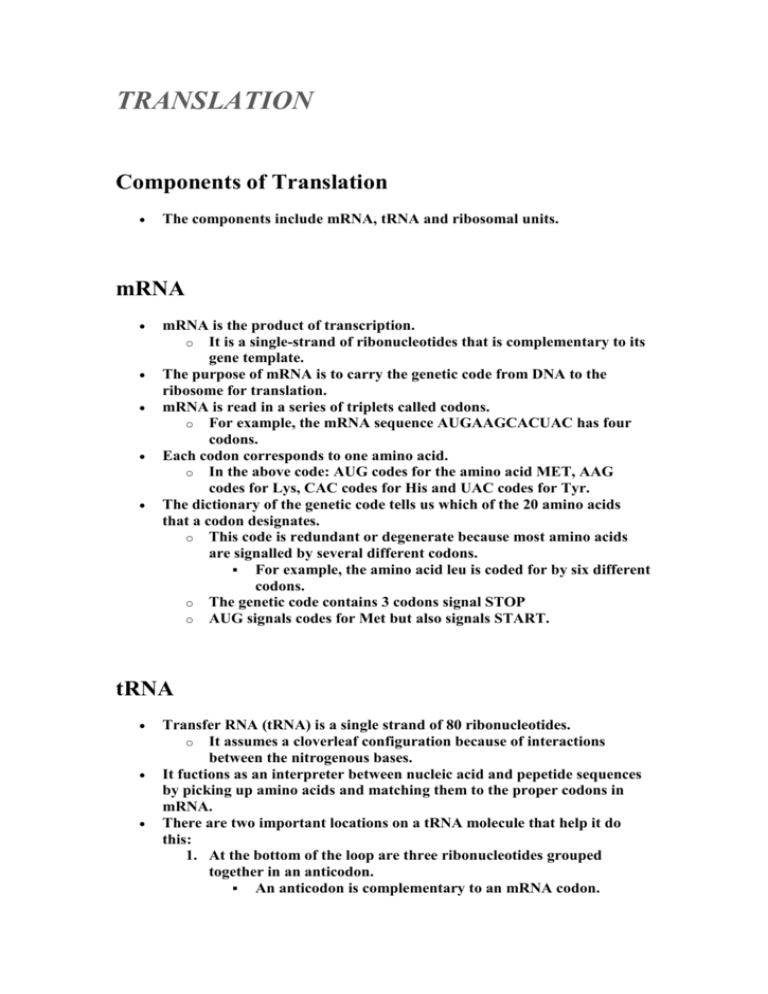
TRANSLATION Components of Translation The components include mRNA, tRNA and ribosomal units. mRNA mRNA is the product of transcription. o It is a single-strand of ribonucleotides that is complementary to its gene template. The purpose of mRNA is to carry the genetic code from DNA to the ribosome for translation. mRNA is read in a series of triplets called codons. o For example, the mRNA sequence AUGAAGCACUAC has four codons. Each codon corresponds to one amino acid. o In the above code: AUG codes for the amino acid MET, AAG codes for Lys, CAC codes for His and UAC codes for Tyr. The dictionary of the genetic code tells us which of the 20 amino acids that a codon designates. o This code is redundant or degenerate because most amino acids are signalled by several different codons. For example, the amino acid leu is coded for by six different codons. o The genetic code contains 3 codons signal STOP o AUG signals codes for Met but also signals START. tRNA Transfer RNA (tRNA) is a single strand of 80 ribonucleotides. o It assumes a cloverleaf configuration because of interactions between the nitrogenous bases. It fuctions as an interpreter between nucleic acid and pepetide sequences by picking up amino acids and matching them to the proper codons in mRNA. There are two important locations on a tRNA molecule that help it do this: 1. At the bottom of the loop are three ribonucleotides grouped together in an anticodon. An anticodon is complementary to an mRNA codon. An anticodon can recognize and bind to its complementary mRNA codon. Some tRNAs can recognize more than one codon because there is a relaxation of the complementation rule of base pairing between the anticodon and codon in the third position. This relaxation is called the Wobble Hypothesis. 2. At the 3’ end of the tRNA strand is where the amino acid attaches to the tRNA molecule. Each tRNA carries one amino acid that corresponds to an mRNA codon. The proper amino acid is joined to the tRNA by the enzyme aminoacyl-tRNA synthetase. There is one type of this enzyme for each amino acid and the active site of each fits only the specific combination of the proper amino acid and tRNA. Ribosomes A ribosome is made of rRNA and proteins. A ribosome is composed of two subunits, a large subunit and a small subunit. o These subunits join to form a functional ribosome when they attach to mRNA. Each ribosome has two binding sites for mRNA: 1. The p-site (peptidyl site) 2. The a-site (aminoacyl site) Translation the process step by step: 1. The small ribosomal subunit binds to the mRNA molecule. At the same time, the initiator tRNA with the anticodon UAC and the amino acid Met binds to the start codon AUG (Remember AUG is the start codon). 2. The large subunit binds to this complex. The initiator tRNA is in the p-site and there is no tRNA in the a-site. 3. A tRNA carrying a second amino acid approaches and enters the empty a site. The anticodon of the tRNA binds to the second codon of mRNA in the a-site. 4. The first amino acid is joined to the second amino acid by a peptide bond. 5. The tRNA that was in the p-site is released and the ribosome moves along the mRNA until the second tRNA is in the p-site. This means the ribosome advances only one codon. The a-site is empty again. 6. A third tRNA approaches and enters the empty a-site. Its anticodon binds to the mRNA codon in the a-site. A peptide bond is formed between the new amino acid in the a-site and the growing peptide chain. The tRNA is released from the p-site and the ribosome advances one codon. 7. This process continues until the ribosome reaches a STOP codon. The STOP codons are UAA, UAG and UGA. When a ribosome reaches a STOP codon, the a-site accepts a protein called a release factor instead of a tRNA. The release factor breaks the bond between the tRNA and the polypeptide. The polypeptide and tRNA are released. The released polypeptide forms a protein.


